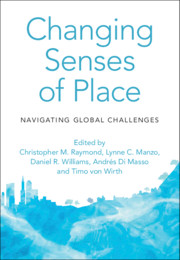Book contents
- Changing Senses of Place
- Changing Senses of Place
- Copyright page
- Dedication
- Contents
- Contributors
- Foreword
- Preface
- Acknowledgements
- Introduction
- Part I Climate Change and Ecological Regime Shifts
- Part II Migration, Mobility and Belonging
- Part III Renewable Energy Transitions
- 10 Farming Landscapes, Energy Landscapes or Both?
- 11 Auto-Photography, Senses of Place and Public Support for Marine Renewable Energy
- 12 A Life Course Approach to the Pluralisation of Sense of Place
- Part IV Nationalism and Competing Territorial Claims
- Part V Urban Change
- Part VI Technological and Legal Transformations
- Part VII Design and Planning Strategies for Changing Senses of Place
- Part VIII Conclusion
- Index
- References
12 - A Life Course Approach to the Pluralisation of Sense of Place
Understanding the Social Acceptance of Low-Carbon Energy Developments
from Part III - Renewable Energy Transitions
Published online by Cambridge University Press: 15 July 2021
- Changing Senses of Place
- Changing Senses of Place
- Copyright page
- Dedication
- Contents
- Contributors
- Foreword
- Preface
- Acknowledgements
- Introduction
- Part I Climate Change and Ecological Regime Shifts
- Part II Migration, Mobility and Belonging
- Part III Renewable Energy Transitions
- 10 Farming Landscapes, Energy Landscapes or Both?
- 11 Auto-Photography, Senses of Place and Public Support for Marine Renewable Energy
- 12 A Life Course Approach to the Pluralisation of Sense of Place
- Part IV Nationalism and Competing Territorial Claims
- Part V Urban Change
- Part VI Technological and Legal Transformations
- Part VII Design and Planning Strategies for Changing Senses of Place
- Part VIII Conclusion
- Index
- References
Summary
In recent years, scholarship in environmental psychology has drawn on a qualitative narrative methodology in order to better understand the temporally dynamic development of different senses of place over the life course, in the form of distinct ‘life-place trajectories’. This research problematises a monistic and static conceptualisation of sense of place, pointing to the development of a plurality of senses of place that evolve temporally across the entire life course, and points to a need to conceptually expand our notions of the concept by recognising the interrelated role of ‘linked lives’ – the influence of interpersonal relations and wider socio-economic, cultural and political forces in the formation of different senses of place and residential mobility decisions over time. Furthermore, this chapter outlines how this life course approach has been applied to better understand the social acceptance of low-carbon energy technology developments.
Keywords
- Type
- Chapter
- Information
- Changing Senses of PlaceNavigating Global Challenges, pp. 156 - 168Publisher: Cambridge University PressPrint publication year: 2021
References
- 1
- Cited by

